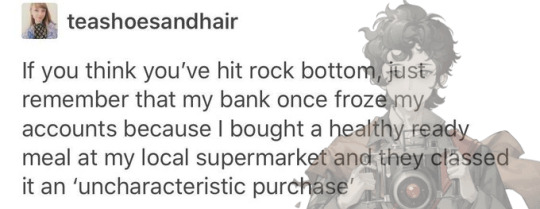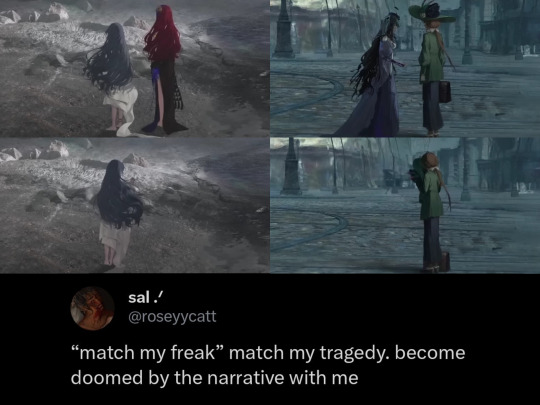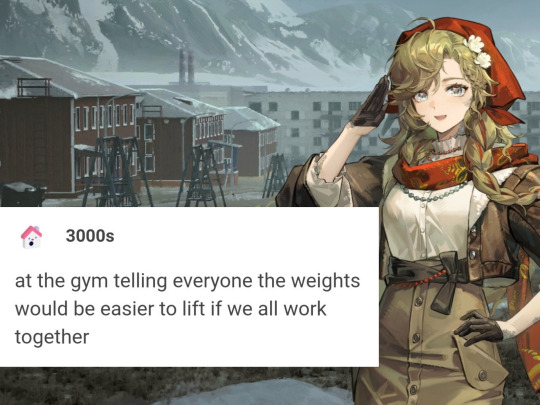#reverse 1999 text post meme
Explore tagged Tumblr posts
Text
Farewell Rayashki text post meme because I'm not immune to the Russian yuri and their adopted son
Part 1 | Part 2 | Part 3 | Part 4












#first we had deer yuri... now we have fish yuri... what's next bluepoch#gotta love the interspecies diversity#reverse 1999#farewell rayashki#vila#windsong#avgust#vilasong#windla#text posts#text post meme#reverse 1999 text post meme#r1999🍄#now presenting vingler's mirror
567 notes
·
View notes
Text

I’m so not normal about them help.
#The silliesssss<333#I love them sm it’s not even funny anymore#need them to make out so bad you don’t understand#text post#reverse 1999#r1999#r1999 1.8#reverse 1999 vila#reverse 1999 windsong#memes#vilasong#windla
188 notes
·
View notes
Text









Reverse 1999 textposts part 1 (see tag rev1999 textposts for all of them)
#reverse 1999#rev1999#reverse: 1999#vertin#schneider#matilda bouanich#sonetto#regulus#text post#text posts#text post meme#tumblr text post#tumblr text meme#rev1999 textposts#tennant#bkornblume#click#x#bette
835 notes
·
View notes
Text

#marian x dikke nation I offer you mimi#i should draw them at some point I love this ship#reverse 1999#Marian Greco#Dikke#r1999#text post#meme
60 notes
·
View notes
Text
MUSIC RESPONSE; ALBUM COVER IMAGERY - Context

(Creative Boom, 2020)
As humans we have been making music for around 35,000 years (The Smithsonian Institution, 2009). It would take Thomas Edison’s invention of the ‘Talking Machine’ in 1877 with a further fifty years of development before what we would now recognise as a vinyl album to exist. Initially housed in plain packaging, the invention of ‘cover art’ is credited to American graphic designer Alex Steinweiss who became the first art director of Columbia Records and is thought to have designed 2500 covers during his long career.
Over the following seventy years the album cover became an important part of the culture of music. The design of the cover was the first visual impression an artist could show their audience, it could reflect how the artist wanted themselves or their music to be perceived; it was their direct sales tool. Certain photographers, artists and graphic designers gained fame solely for their work on album covers.
In 1988 CD sales eclipsed vinyl, and in 1991 they eclipsed the cassette. The physical size of the album cover was less than quarter that of it’s vinyl predecessor. At just 12cm square and usually housed in a plastic jewel case the impact of cover art was starting to fade. Around 1999 was the peak point of sales of physical music; it was also the beginning of the end. With the birth of peer-to-peer network Napster the digital music revolution had begun.

By 2007 digital music outsold its physical counterpart. Album covers became 1600 pixel square and viewed on a screen. Fast forward nine years and the digital music revolution takes a new turn; streaming music on demand eclipses owning music in any form; digital or physical. Cover art shrinks again to just 300x300 pixels. Today in 2020 music streaming accounts for approx 80% of all music listened to.
So where does that leave music artwork? It’s not all bad news according to Eric Skelton of Complex;

Perhaps now more than ever artists have to think like a brand. In years gone by record art had to compete with other record art on the racks in the store that the consumer had visited because they wanted to buy a record. Now with social media an artists visual branding is competing with every type of brand, every photo, meme, latest viral video, breaking news etc; cover art has to work harder, faster, better and stronger than ever before to capture an audience. In that split second decision it takes to hook the customer in it’s now up to the musician to turn the streaming user into a fan. Streaming sites don’t make artists much if any money, with the global pandemic of 2020 festivals and live shows were cancelled; rightly or wrongly the way for artists to make money right now is through merchandise. And merchandise needs visuals.
Just as it always has done, a strong visual identity sells. Gone may be the days of going to a record store and discovering new artists or music through their album art. Now it could be argued the roles have been reversed, an artists music and brand now sells that very same album. Vinyl has become the merchandise. With the digital version available in high quality at the touch of a button a fan doesn’t need to buy a physical version of the music but they might just if they form an emotional attachment to the cover art and want a physical representation of their favourite artist.
A lot may have changed in the 80 years since Alex Steinweiss first put pen to record sleeve but the role cover art plays, just like every other aspect of the music business, continues to develop and evolve.
References
Cowan, K (2019) Malcolm Garrett - Creative Boom [Podcast] 10 Feb 2020. Available at https://www.creativeboom.com/podcast/malcolm-garrett/
Caramanica, J. (2019) What’s the Point of Album Covers in the Post-Album Era? The New York Times. [Podcast] 29 Aug. Available at: https://www.nytimes.com/2019/08/29/arts/music/popcast-album-art.html.
The Smithsonian Institution’s Human Origins Program. (2009). Art & Music. [online] Available at: https://humanorigins.si.edu/evidence/behavior/art-music#:~:text=and%20social%20status.- [Accessed 12 Oct. 2020].
Wikipedia Contributors (2019). Phonograph record. [online] Wikipedia. Available at: https://en.wikipedia.org/wiki/Phonograph_record.
Skelton, E. Complex. (2017). Why Cover Art Is More Important Than Ever. [online] Available at: https://www.complex.com/pigeons-and-planes/2017/04/should-we-still-care-about-cover-art [Accessed 13 Oct. 2020].
2 notes
·
View notes
Text
June 29, 1999.
!! before you follow !!
⋄ first of all, i am not a shalladin blog or shipper in the slightest and im not sure where the idea that i am is coming from?? i just dont do public ship hate. i have my own opinions but i try not to get involved in ship discourse.
⋄ i am an ace, genderfluid lesbian that prefers they/them pronouns. im also a christian. and i only say that bc the idea of ‘its okay for me to not support ___ bc of my religion!!’ is not okay nor is it welcome here in the slightest. you can be religious and still be accepting and open-minded. its not that hard.
⋄ ^ there arent really a lot of religious posts on tumblr so dont worry i wont reblog anything that might annoy you/go against ur own beliefs gfnkhnfk
⋄ i dont really curse or like nsfw in the slightest so idk dont try to get me to do either?? idc if u curse but i dont like one-on-one talk about anything nsfw :// if u tag it youre fine
⋄ i also go by the paladin handbook for ages but i wont shove anything in ur face. if the creators come out and say that the ages are different than i’ll go by those instead!!
⋄ i would die for lance mcclain and keith kogane. they make me believe being hetero is a possibility for me……
⋄ dont come @ me with memes theres a 99% chances i wont know what ur talking about i cant keep up with anything snkgnkhgf
⋄ i keysmash + talk in tags
⋄ i love klance and tododeku!!! a lot!! absolute faves and i post about them a lot
⋄ i tag ships!!! ur safe!
⋄ rarely if ever get involved in discourse. im too tired
⋄ i dont always follow back anymore so dont only follow for a fb :(
⋄ i used to ship lotura, kidge and shallura but i do not at this point. sorry if theyre stuck somewhere in my tags :p kinda on the fence with allurance rn
!! do not follow if !!
⋄ u post untagged shalladin pairings (ESP SHIDGE!!!). i dont know i struggle w/ the ships for a lot of reasons.
⋄ not a fan of lotor/paladin ships either but if u tag it or rarely post it i can deal
⋄ if u support tauradonna please leave. im sorry but theres nothing good about this ship at this point. its nothing more than an abusive, one-sided obsession with a major power inbalance and it goes against everything blake stands for as a character now. ://
⋄ and if u ship cinder/emerald too. its another abusive and one-sided relationship!!! gross!!
⋄ u dont think aro/aces belong in the LGBT+ community and openly post about it.
⋄ u hate text talk. i got news for u pal :)
⋄ u support donald trump and the people who work under him (esp pence). same goes if youre a hardcore right-wing enthusiast and close-minded conservative.
⋄ u believe in reverse racism or believe suppressed ppl should be allowed to act/joke racist to other suppressed ppl
⋄ u believe……….in…t..hhe…moon.landing…fndkngkfd
abt ⋄ ⋄ faqs
6 notes
·
View notes
Text
No More Hacks: Why Tired, Old, Boring Processes Can Make You a Better Marketer
Israeli researchers studied 200 of the best ads in 1999.
These were the top finalists and award winners, like the infamous “This is Your Brain on Drugs” campaign from years ago.
The most surprising thing? They weren’t ‘creative’.
89% of them could be classified into six ‘templates’, which were classified in the excellent Made to Stick.
The point?
Ideas aren’t in short supply today. Execution is.
The reason results aren’t kicking in like you expect is NOT because you’re missing some mythical growth hack. It’s because you’re not executing on the basics right in front of your face.
Here’s why, along with a few examples to get started.
The Escalating Content Marketing Arms Race
A 500-word blog post used take an hour or two to complete.
Problem? Nobody writes 500 words anymore. At least, not if they want results.
You know what it takes to get on the first page of Google today? 1,890 words. Thanks, Skyscrapers.
That’s backed up by excellent research from Orbit Media, whose survey results show that the average blog post is 1054 words long (19% longer than in 2015).
Image Source
Which means, they take longer to write, too. Today’s average blog post takes 3 hours 16 minutes to write (26% increase over 2015).
Image Source
Buffer has been spending a minimum of three hours on each post for years now. And some savvy marketers admit that they spend half-to-a-full day on one blog post.
The bar is high.
And it keeps getting higher.
We haven’t even touched on the quantity: two million blog posts published each day. (And that was already a few years ago in 2015!)
Not seeing results from blogging?
How much time are you spending on each post?
Most likely, it’s not enough. Because you’re too busy responding to client calls, boss’s emails, memes on Slack, or scouring Inbound.org and Growth Hackers for the latest silver bullet hack that will deliver instant success.
When the brutal truth is that the only way out, is the one path in front of you.
It’s the most obvious, yet least exciting option.
Don’t look at what those Inbound & Growth Hackers posts say. Look at what they’re doing.
The depth. The insight (based on real-world experience). The multimedia. And then replicate it.
In today’s world, average doesn’t cut it. Only exceptional gets rankings, traffic, leads, and sales.
Trouble is, there ain’t anymore hours in the day.
How are you supposed to do it?
The AdWords Quality Score
Back in the old days, AdWords was more of a straight-forward auction.
That meant anyone could bid as much as they wanted on whichever keyphrases they chose in order to generate more results.
But that came at the expense of relevance for us consumers.
Now, the Google’s ain’t dumb. So they introduced a few tweaks to the system, including the Quality Score.
Today it’s an approximation for how your results should perform in aggregate. And one of the things it looks for, is message match.
That is, an alignment between:
What someone’s searching for
The ads they see (that you create)
And the landing page they visit upon clicking
Long story short, this little guy plays a role in determining what you pay. The higher that number goes, based on a better ‘alignment’ between those three variables above (and a few more), the less you pay to drive traffic, net leads, and close sales.
Facebook’s got a similar metric, the Relevance Score, that says even a little boost in engagement (of 1%) is enough to deliver a 5% cost reduction!
Here’s the best news.
Quality Scores aren’t secret. Unlike Google’s organic algorithm, they tell you pretty much how it’s determined. Which means it should be a straightforward path to fixing.
You simply identify a few popular campaigns that are underperforming…
Image Source
Spin those out into their own campaigns to improve the keywords you’re targeting, the ads you’re showing, and the landing pages visitors are finding, in order to increase their overall experience.
Sure. There’s a little more involved. But that’s the basics. And just making those basic improvements can increase AdWords lead conversion rates 900% while also dropping Cost Per Conversions 99%.
Image Source
No tricks or hacks. Just execution.
Look.
It’s easy. All the information is out there in the open.
Take ad copy specifically.
Increase Ad Performance & Slash Your Time in Half by Systemizing Ad Copy Writing
These are a B– to write.
Only a few short characters. You’d think it’d be easy.
But you sit there and stare at a blank screen for twenty minutes before ever writing down a single headline variation or two.
Here’s the secret though.
Even if you’ve worked in this space for years, you have no idea how it’s going to work. You kinda do, but no guarantees in this game.
So relax. Use a system.
Digital Marketer’s Ad Grid is one of the best ‘frameworks’ to base your ad writing.
At the top of a grid, list out your customer personas. On the left, just simply copy-and-paste what they’re already spoon-feeding you: different proven ‘hooks’ that each tug at your prospect’s emotional, lizard brain telling them WHY they should care (to click, sign up, or change their ways).
Image Source
We’re not going into tactics here. But we don’t have to. It’s all there in that article. One of the keepers to follow and rip off (or emulate).
Now, ad writing should be easy. The hooks and messaging are in place for each segment or persona. Obviously adapted depending on the industry you’re working in.
Let’s use an example from my friends, The Yes Girls.
You can try the ‘zen’ approach, simplifying the life of consumers so they don’t have to worry ‘bout a thing.
Or you can go the complete opposite route, focusing instead on helping people protect themselves from mistakes they’re making.
This gets even easier in some highly formulaic industries.
Take local businesses. People look for these companies by searching for: [Location] + [Service]. So guess what keyphrases to choose, what to write in your ads, and what to put smack-dab on the middle of your landing page headline?
In these cases you don’t even have to reinvent the wheel. Click-through rate busting ads aren’t far away. It’s just a matter of writing a few variations (based on a solid framework or process) and then letting the winner surface to the top after a few days-to-a-week.
How to Create Nimble Marketing Processes that Can Adapt & Change On-the-Fly
Processes are mechanical. They’re routine. And they kinda suck to write.
But they’re the only way out.
If you (a) can’t work anymore hours in a day without dropping dead or getting divorced, and (b) need to UP your execution game so that results come quicker for clients and bosses, there’s only one solution my friend.
Rising PPC star, Jonathan Dane, admitted to almost quitting three times in the first year after starting Klientboost.
Then they systematically improved parts of the business (heavily influenced by The E-Myth) and are now doing over $3 million a year (in only about three years).
Ok. So where to start.
Step #1. Reverse-Engineer a Step-by-Step Process You Intuitively Already Do on a Daily Basis
It’s tempting to org-chart the hell out of your biz, but it’ll only stress you out more. It’s too much. Too big of a chunk.
Take something small. Like PPC ad writing. Or blog content.
And from A to Z, list out the steps you already take. OR, the steps you’d like to take based on the excellent example you see somewhere online already. Whatever. Doesn’t matter.
Here, I’ll even give you an internal example.
Step 7 of our “How to Create a Blog Post” process is about creating headlines. And I just straight stole the answers from Jon Morrow’s Headline Hacks – because it’s amazing, simple and straightforward. Someone with little-to-no blogging skillz can follow one of these and churn out a not-terrible headline on their first try.
Step #2. Visually Map the ‘Transitions’ that Need to Take Place After Completing One Action Before Starting Another
Zooming into a specific step or activity helps you see how tired, boring-old processes can deliver the goods.
But the real benefit in comes when you see the transitions; how you go from completing one thing to starting the next.
Mind mapping can help you visualize how all of these pieces fit together. XMind is one, but certainly not the only, option.
Here’s another personal example of the customer journey, along with How and What and Who from our side will align with each step.
So peeps complete Steps 1, 2, and 3. Great. Then what?
Processes create systems. And the best systems are a collection of subsystems. I think I just plagiarized that from Work the System.
The point, though, is not to lose sight of the forest for the trees.
Step #3. Make Processes Actionable & Accountable with Intuitive Tools that Reinforce the Actions You Want
Next step is to make this idea come to life. A Word doc is great… for getting lost on your hard drive somewhere.
But the next step is to use some tool – again, doesn’t matter which – to capture and manage and assign and enforce the system you just created.
My favorite is Pipefy. It’s amazing. Time-consuming to get right. But powerful once you get workflows up-and-running which allow other team members or contractors to step into various parts and do the job 80% as well as you.
Because that’s the goal at first. 80%. Transferring your years of experience and pattern matching and hard lessons isn’t easy. But over time you’ll learn how to create a process that enforces good habits and helps people bypass that learning curve.
Pipefy even has a few templates you can import to get started. Including, an SEM management one. How apropos.
The individual step (in the image above) can’t be completed until someone fills out each text box with an answer.
Once that’s done, you move onto the next step which will then bring up a new list of instructions, video tutorials, image examples, and more for the next person to know exactly what’s expected of them.
Which brings us to people.
Step #4. Processes Can Make Good People Better; Empowering Novices to Perform like Experts
Marketers live in a results-driven business. The pressure’s on.
One study says working in media is almost as stressful as flying a plane or cutting into people!
Image Source
Which means we usually have a short leash (and shorter temper) when it comes to those around us. If they can’t keep up, they’re not around long. #realtalk
Good people are hard to find. The ones who can read your thoughts and are already a step ahead.
These people should also be incredibly cheap in the grand scheme of things. Like, you can’t afford not too, cheap. That’s meant in a rational businessperson, not insensitive, way. They’re an asset, not an expense.
But they can’t be thrown into the deep end. Even contractors, who’re subject-level experts, need help understanding what you’re thinking and what you’re looking for. They won’t get it on the first try.
So whether you’re hiring new marketers or working with outside people (I’ve had great experiences so far with Worldwide101 ← and I don’t receive anything for saying that), the best thing you can do is plug them into a process.
People shouldn’t cause you to take more time out of your already busy schedule. They should add back chunks of time, while multiplying and leveraging your ability to execute.
But that’s only possible if they know exactly, step-by-step, what to do and why.
Conclusion
I hope this doesn’t come off as preachy. That wasn’t the intent.
I’ve personally wasted (and continue to waste) countless hours reading, instead of doing.
Chances are, you’re similar. You already know what it takes, or where to find it.
And there’s only so many hours in the day. You can’t possibly put in anymore.
So piling on another ‘hack’ to your already overflowing to-do list isn’t going to help.
Bookmark it. Save it in Evernote. Someday/Maybe it. And revisit it later.
For now, focus on improving your processes to get vastly more done in less time.
Execution dictates results. Not hacks.
About the Author: Brad Smith is a marketing writer, agency partner, and creator of Copy Weekly, a free weekly copywriting newsletter for marketers & founders.
http://ift.tt/2mcdHwq from MarketingRSS http://ift.tt/2mOlh3s via Youtube
0 notes
Text
No More Hacks: Why Tired, Old, Boring Processes Can Make You a Better Marketer
Israeli researchers studied 200 of the best ads in 1999.
These were the top finalists and award winners, like the infamous “This is Your Brain on Drugs” campaign from years ago.
The most surprising thing? They weren’t ‘creative’.
89% of them could be classified into six ‘templates’, which were classified in the excellent Made to Stick.
The point?
Ideas aren’t in short supply today. Execution is.
The reason results aren’t kicking in like you expect is NOT because you’re missing some mythical growth hack. It’s because you’re not executing on the basics right in front of your face.
Here’s why, along with a few examples to get started.
The Escalating Content Marketing Arms Race
A 500-word blog post used take an hour or two to complete.
Problem? Nobody writes 500 words anymore. At least, not if they want results.
You know what it takes to get on the first page of Google today? 1,890 words. Thanks, Skyscrapers.
That’s backed up by excellent research from Orbit Media, whose survey results show that the average blog post is 1054 words long (19% longer than in 2015).
Image Source
Which means, they take longer to write, too. Today’s average blog post takes 3 hours 16 minutes to write (26% increase over 2015).
Image Source
Buffer has been spending a minimum of three hours on each post for years now. And some savvy marketers admit that they spend half-to-a-full day on one blog post.
The bar is high.
And it keeps getting higher.
We haven’t even touched on the quantity: two million blog posts published each day. (And that was already a few years ago in 2015!)
Not seeing results from blogging?
How much time are you spending on each post?
Most likely, it’s not enough. Because you’re too busy responding to client calls, boss’s emails, memes on Slack, or scouring Inbound.org and Growth Hackers for the latest silver bullet hack that will deliver instant success.
When the brutal truth is that the only way out, is the one path in front of you.
It’s the most obvious, yet least exciting option.
Don’t look at what those Inbound & Growth Hackers posts say. Look at what they’re doing.
The depth. The insight (based on real-world experience). The multimedia. And then replicate it.
In today’s world, average doesn’t cut it. Only exceptional gets rankings, traffic, leads, and sales.
Trouble is, there ain’t anymore hours in the day.
How are you supposed to do it?
The AdWords Quality Score
Back in the old days, AdWords was more of a straight-forward auction.
That meant anyone could bid as much as they wanted on whichever keyphrases they chose in order to generate more results.
But that came at the expense of relevance for us consumers.
Now, the Google’s ain’t dumb. So they introduced a few tweaks to the system, including the Quality Score.
Today it’s an approximation for how your results should perform in aggregate. And one of the things it looks for, is message match.
That is, an alignment between:
What someone’s searching for
The ads they see (that you create)
And the landing page they visit upon clicking
Long story short, this little guy plays a role in determining what you pay. The higher that number goes, based on a better ‘alignment’ between those three variables above (and a few more), the less you pay to drive traffic, net leads, and close sales.
Facebook’s got a similar metric, the Relevance Score, that says even a little boost in engagement (of 1%) is enough to deliver a 5% cost reduction!
Here’s the best news.
Quality Scores aren’t secret. Unlike Google’s organic algorithm, they tell you pretty much how it’s determined. Which means it should be a straightforward path to fixing.
You simply identify a few popular campaigns that are underperforming…
Image Source
Spin those out into their own campaigns to improve the keywords you’re targeting, the ads you’re showing, and the landing pages visitors are finding, in order to increase their overall experience.
Sure. There’s a little more involved. But that’s the basics. And just making those basic improvements can increase AdWords lead conversion rates 900% while also dropping Cost Per Conversions 99%.
Image Source
No tricks or hacks. Just execution.
Look.
It’s easy. All the information is out there in the open.
Take ad copy specifically.
Increase Ad Performance & Slash Your Time in Half by Systemizing Ad Copy Writing
These are a B– to write.
Only a few short characters. You’d think it’d be easy.
But you sit there and stare at a blank screen for twenty minutes before ever writing down a single headline variation or two.
Here’s the secret though.
Even if you’ve worked in this space for years, you have no idea how it’s going to work. You kinda do, but no guarantees in this game.
So relax. Use a system.
Digital Marketer’s Ad Grid is one of the best ‘frameworks’ to base your ad writing.
At the top of a grid, list out your customer personas. On the left, just simply copy-and-paste what they’re already spoon-feeding you: different proven ‘hooks’ that each tug at your prospect’s emotional, lizard brain telling them WHY they should care (to click, sign up, or change their ways).
Image Source
We’re not going into tactics here. But we don’t have to. It’s all there in that article. One of the keepers to follow and rip off (or emulate).
Now, ad writing should be easy. The hooks and messaging are in place for each segment or persona. Obviously adapted depending on the industry you’re working in.
Let’s use an example from my friends, The Yes Girls.
You can try the ‘zen’ approach, simplifying the life of consumers so they don’t have to worry ‘bout a thing.
Or you can go the complete opposite route, focusing instead on helping people protect themselves from mistakes they’re making.
This gets even easier in some highly formulaic industries.
Take local businesses. People look for these companies by searching for: [Location] + [Service]. So guess what keyphrases to choose, what to write in your ads, and what to put smack-dab on the middle of your landing page headline?
In these cases you don’t even have to reinvent the wheel. Click-through rate busting ads aren’t far away. It’s just a matter of writing a few variations (based on a solid framework or process) and then letting the winner surface to the top after a few days-to-a-week.
How to Create Nimble Marketing Processes that Can Adapt & Change On-the-Fly
Processes are mechanical. They’re routine. And they kinda suck to write.
But they’re the only way out.
If you (a) can’t work anymore hours in a day without dropping dead or getting divorced, and (b) need to UP your execution game so that results come quicker for clients and bosses, there’s only one solution my friend.
Rising PPC star, Jonathan Dane, admitted to almost quitting three times in the first year after starting Klientboost.
Then they systematically improved parts of the business (heavily influenced by The E-Myth) and are now doing over $3 million a year (in only about three years).
Ok. So where to start.
Step #1. Reverse-Engineer a Step-by-Step Process You Intuitively Already Do on a Daily Basis
It’s tempting to org-chart the hell out of your biz, but it’ll only stress you out more. It’s too much. Too big of a chunk.
Take something small. Like PPC ad writing. Or blog content.
And from A to Z, list out the steps you already take. OR, the steps you’d like to take based on the excellent example you see somewhere online already. Whatever. Doesn’t matter.
Here, I’ll even give you an internal example.
Step 7 of our “How to Create a Blog Post” process is about creating headlines. And I just straight stole the answers from Jon Morrow’s Headline Hacks – because it’s amazing, simple and straightforward. Someone with little-to-no blogging skillz can follow one of these and churn out a not-terrible headline on their first try.
Step #2. Visually Map the ‘Transitions’ that Need to Take Place After Completing One Action Before Starting Another
Zooming into a specific step or activity helps you see how tired, boring-old processes can deliver the goods.
But the real benefit in comes when you see the transitions; how you go from completing one thing to starting the next.
Mind mapping can help you visualize how all of these pieces fit together. XMind is one, but certainly not the only, option.
Here’s another personal example of the customer journey, along with How and What and Who from our side will align with each step.
So peeps complete Steps 1, 2, and 3. Great. Then what?
Processes create systems. And the best systems are a collection of subsystems. I think I just plagiarized that from Work the System.
The point, though, is not to lose sight of the forest for the trees.
Step #3. Make Processes Actionable & Accountable with Intuitive Tools that Reinforce the Actions You Want
Next step is to make this idea come to life. A Word doc is great… for getting lost on your hard drive somewhere.
But the next step is to use some tool – again, doesn’t matter which – to capture and manage and assign and enforce the system you just created.
My favorite is Pipefy. It’s amazing. Time-consuming to get right. But powerful once you get workflows up-and-running which allow other team members or contractors to step into various parts and do the job 80% as well as you.
Because that’s the goal at first. 80%. Transferring your years of experience and pattern matching and hard lessons isn’t easy. But over time you’ll learn how to create a process that enforces good habits and helps people bypass that learning curve.
Pipefy even has a few templates you can import to get started. Including, an SEM management one. How apropos.
The individual step (in the image above) can’t be completed until someone fills out each text box with an answer.
Once that’s done, you move onto the next step which will then bring up a new list of instructions, video tutorials, image examples, and more for the next person to know exactly what’s expected of them.
Which brings us to people.
Step #4. Processes Can Make Good People Better; Empowering Novices to Perform like Experts
Marketers live in a results-driven business. The pressure’s on.
One study says working in media is almost as stressful as flying a plane or cutting into people!
Image Source
Which means we usually have a short leash (and shorter temper) when it comes to those around us. If they can’t keep up, they’re not around long. #realtalk
Good people are hard to find. The ones who can read your thoughts and are already a step ahead.
These people should also be incredibly cheap in the grand scheme of things. Like, you can’t afford not too, cheap. That’s meant in a rational businessperson, not insensitive, way. They’re an asset, not an expense.
But they can’t be thrown into the deep end. Even contractors, who’re subject-level experts, need help understanding what you’re thinking and what you’re looking for. They won’t get it on the first try.
So whether you’re hiring new marketers or working with outside people (I’ve had great experiences so far with Worldwide101 ← and I don’t receive anything for saying that), the best thing you can do is plug them into a process.
People shouldn’t cause you to take more time out of your already busy schedule. They should add back chunks of time, while multiplying and leveraging your ability to execute.
But that’s only possible if they know exactly, step-by-step, what to do and why.
Conclusion
I hope this doesn’t come off as preachy. That wasn’t the intent.
I’ve personally wasted (and continue to waste) countless hours reading, instead of doing.
Chances are, you’re similar. You already know what it takes, or where to find it.
And there’s only so many hours in the day. You can’t possibly put in anymore.
So piling on another ‘hack’ to your already overflowing to-do list isn’t going to help.
Bookmark it. Save it in Evernote. Someday/Maybe it. And revisit it later.
For now, focus on improving your processes to get vastly more done in less time.
Execution dictates results. Not hacks.
About the Author: Brad Smith is a marketing writer, agency partner, and creator of Copy Weekly, a free weekly copywriting newsletter for marketers & founders.
0 notes
Text
No More Hacks: Why Tired, Old, Boring Processes Can Make You a Better Marketer
Israeli researchers studied 200 of the best ads in 1999.
These were the top finalists and award winners, like the infamous “This is Your Brain on Drugs” campaign from years ago.
The most surprising thing? They weren’t ‘creative’.
89% of them could be classified into six ‘templates’, which were classified in the excellent Made to Stick.
The point?
Ideas aren’t in short supply today. Execution is.
The reason results aren’t kicking in like you expect is NOT because you’re missing some mythical growth hack. It’s because you’re not executing on the basics right in front of your face.
Here’s why, along with a few examples to get started.
The Escalating Content Marketing Arms Race
A 500-word blog post used take an hour or two to complete.
Problem? Nobody writes 500 words anymore. At least, not if they want results.
You know what it takes to get on the first page of Google today? 1,890 words. Thanks, Skyscrapers.
That’s backed up by excellent research from Orbit Media, whose survey results show that the average blog post is 1054 words long (19% longer than in 2015).
Image Source
Which means, they take longer to write, too. Today’s average blog post takes 3 hours 16 minutes to write (26% increase over 2015).
Image Source
Buffer has been spending a minimum of three hours on each post for years now. And some savvy marketers admit that they spend half-to-a-full day on one blog post.
The bar is high.
And it keeps getting higher.
We haven’t even touched on the quantity: two million blog posts published each day. (And that was already a few years ago in 2015!)
Not seeing results from blogging?
How much time are you spending on each post?
Most likely, it’s not enough. Because you’re too busy responding to client calls, boss’s emails, memes on Slack, or scouring Inbound.org and Growth Hackers for the latest silver bullet hack that will deliver instant success.
When the brutal truth is that the only way out, is the one path in front of you.
It’s the most obvious, yet least exciting option.
Don’t look at what those Inbound & Growth Hackers posts say. Look at what they’re doing.
The depth. The insight (based on real-world experience). The multimedia. And then replicate it.
In today’s world, average doesn’t cut it. Only exceptional gets rankings, traffic, leads, and sales.
Trouble is, there ain’t anymore hours in the day.
How are you supposed to do it?
The AdWords Quality Score
Back in the old days, AdWords was more of a straight-forward auction.
That meant anyone could bid as much as they wanted on whichever keyphrases they chose in order to generate more results.
But that came at the expense of relevance for us consumers.
Now, the Google’s ain’t dumb. So they introduced a few tweaks to the system, including the Quality Score.
Today it’s an approximation for how your results should perform in aggregate. And one of the things it looks for, is message match.
That is, an alignment between:
What someone’s searching for
The ads they see (that you create)
And the landing page they visit upon clicking
Long story short, this little guy plays a role in determining what you pay. The higher that number goes, based on a better ‘alignment’ between those three variables above (and a few more), the less you pay to drive traffic, net leads, and close sales.
Facebook’s got a similar metric, the Relevance Score, that says even a little boost in engagement (of 1%) is enough to deliver a 5% cost reduction!
Here’s the best news.
Quality Scores aren’t secret. Unlike Google’s organic algorithm, they tell you pretty much how it’s determined. Which means it should be a straightforward path to fixing.
You simply identify a few popular campaigns that are underperforming…
Image Source
Spin those out into their own campaigns to improve the keywords you’re targeting, the ads you’re showing, and the landing pages visitors are finding, in order to increase their overall experience.
Sure. There’s a little more involved. But that’s the basics. And just making those basic improvements can increase AdWords lead conversion rates 900% while also dropping Cost Per Conversions 99%.
Image Source
No tricks or hacks. Just execution.
Look.
It’s easy. All the information is out there in the open.
Take ad copy specifically.
Increase Ad Performance & Slash Your Time in Half by Systemizing Ad Copy Writing
These are a B– to write.
Only a few short characters. You’d think it’d be easy.
But you sit there and stare at a blank screen for twenty minutes before ever writing down a single headline variation or two.
Here’s the secret though.
Even if you’ve worked in this space for years, you have no idea how it’s going to work. You kinda do, but no guarantees in this game.
So relax. Use a system.
Digital Marketer’s Ad Grid is one of the best ‘frameworks’ to base your ad writing.
At the top of a grid, list out your customer personas. On the left, just simply copy-and-paste what they’re already spoon-feeding you: different proven ‘hooks’ that each tug at your prospect’s emotional, lizard brain telling them WHY they should care (to click, sign up, or change their ways).
Image Source
We’re not going into tactics here. But we don’t have to. It’s all there in that article. One of the keepers to follow and rip off (or emulate).
Now, ad writing should be easy. The hooks and messaging are in place for each segment or persona. Obviously adapted depending on the industry you’re working in.
Let’s use an example from my friends, The Yes Girls.
You can try the ‘zen’ approach, simplifying the life of consumers so they don’t have to worry ‘bout a thing.
Or you can go the complete opposite route, focusing instead on helping people protect themselves from mistakes they’re making.
This gets even easier in some highly formulaic industries.
Take local businesses. People look for these companies by searching for: [Location] + [Service]. So guess what keyphrases to choose, what to write in your ads, and what to put smack-dab on the middle of your landing page headline?
In these cases you don’t even have to reinvent the wheel. Click-through rate busting ads aren’t far away. It’s just a matter of writing a few variations (based on a solid framework or process) and then letting the winner surface to the top after a few days-to-a-week.
How to Create Nimble Marketing Processes that Can Adapt & Change On-the-Fly
Processes are mechanical. They’re routine. And they kinda suck to write.
But they’re the only way out.
If you (a) can’t work anymore hours in a day without dropping dead or getting divorced, and (b) need to UP your execution game so that results come quicker for clients and bosses, there’s only one solution my friend.
Rising PPC star, Jonathan Dane, admitted to almost quitting three times in the first year after starting Klientboost.
Then they systematically improved parts of the business (heavily influenced by The E-Myth) and are now doing over $3 million a year (in only about three years).
Ok. So where to start.
Step #1. Reverse-Engineer a Step-by-Step Process You Intuitively Already Do on a Daily Basis
It’s tempting to org-chart the hell out of your biz, but it’ll only stress you out more. It’s too much. Too big of a chunk.
Take something small. Like PPC ad writing. Or blog content.
And from A to Z, list out the steps you already take. OR, the steps you’d like to take based on the excellent example you see somewhere online already. Whatever. Doesn’t matter.
Here, I’ll even give you an internal example.
Step 7 of our “How to Create a Blog Post” process is about creating headlines. And I just straight stole the answers from Jon Morrow’s Headline Hacks – because it’s amazing, simple and straightforward. Someone with little-to-no blogging skillz can follow one of these and churn out a not-terrible headline on their first try.
Step #2. Visually Map the ‘Transitions’ that Need to Take Place After Completing One Action Before Starting Another
Zooming into a specific step or activity helps you see how tired, boring-old processes can deliver the goods.
But the real benefit in comes when you see the transitions; how you go from completing one thing to starting the next.
Mind mapping can help you visualize how all of these pieces fit together. XMind is one, but certainly not the only, option.
Here’s another personal example of the customer journey, along with How and What and Who from our side will align with each step.
So peeps complete Steps 1, 2, and 3. Great. Then what?
Processes create systems. And the best systems are a collection of subsystems. I think I just plagiarized that from Work the System.
The point, though, is not to lose sight of the forest for the trees.
Step #3. Make Processes Actionable & Accountable with Intuitive Tools that Reinforce the Actions You Want
Next step is to make this idea come to life. A Word doc is great… for getting lost on your harddrive somewhere.
But the next step is to use some tool – again, doesn’t matter which – to capture and manage and assign and enforce the system you just created.
My favorite is Pipefy. It’s amazing. Time-consuming to get right. But powerful once you get workflows up-and-running which allow other team members or contractors to step into various parts and do the job 80% as well as you.
Because that’s the goal at first. 80%. Transferring your years of experience and pattern matching and hard lessons isn’t easy. But over time you’ll learn how to create a process that enforces good habits and helps people bypass that learning curve.
Pipefy even has a few templates you can import to get started. Including, an SEM management one. How apropos.
The individual step (in the image above) can’t be completed until someone fills out each text box with an answer.
Once that’s done, you move onto the next step which will then bring up a new list of instructions, video tutorials, image examples, and more for the next person to know exactly what’s expected of them.
Which brings us to people.
Step #4. Processes Can Make Good People Better; Empowering Novices to Perform like Experts
Marketers live in a results-driven business. The pressure’s on.
One study says working in media is almost as stressful as flying a plane or cutting into people!
Image Source
Which means we usually have a short leash (and shorter temper) when it comes to those around us. If they can’t keep up, they’re not around long. #realtalk
Good people are hard to find. The ones who can read your thoughts and are already a step ahead.
These people should also be incredibly cheap in the grand scheme of things. Like, you can’t afford not too, cheap. That’s meant in a rational business-person, not insensitive, way. They’re an asset, not an expense.
But they can’t be thrown into the deep end. Even contractors, who’re subject-level experts, need help understanding what you’re thinking and what you’re looking for. They won’t get it on the first try.
So whether you’re hiring new marketers or working with outside people (I’ve had great experiences so far with Worldwide101 ← and I don’t receive anything for saying that), the best thing you can do is plug them into a process.
People shouldn’t cause you to take more time out of your already busy schedule. They should add back chunks of time, while multiplying and leveraging your ability to execute.
But that’s only possible if they know exactly, step-by-step, what to do and why.
Conclusion
I hope this doesn’t come off as preachy. That wasn’t the intent.
I’ve personally wasted (and continue to waste) countless hours reading, instead of doing.
Chances are, you’re similar. You already know what it takes, or where to find it.
And there’s only so many hours in the day. You can’t possibly put in anymore.
So piling on another ‘hack’ to your already overflowing to-do list isn’t going to help.
Bookmark it. Save it in Evernote. Someday/Maybe it. And revisit it later.
For now, focus on improving your processes to get vastly more done in less time.
Execution dictates results. Not hacks.
About the Author: Brad Smith is a marketing writer, agency partner, and creator of Copy Weekly, a free weekly copywriting newsletter for marketers & founders.
No More Hacks: Why Tired, Old, Boring Processes Can Make You a Better Marketer
0 notes
Text
Silly text post memes I made to cope with Chapter 6
Part 1 | Part 2 | Part 3 | Part 4










#it's been weeks since the chapter was released and I still haven't recovered#I posted these on reddit before but it'd be a dishonor to not post these on tumblr too. it's the origin of all text post memes#reverse 1999#e lucevan le stelle#marcus#isolde#kakania#isokania#reverse 1999 text post meme#r1999🍄#now presenting vingler's mirror
501 notes
·
View notes
Text
Vereinsamt text post meme because we're being practical, involved, and suffering with this patch
Part 1 | Part 2
























#I know it's already 2.0 but I'm still stuck with 1.9 and not ready to let go#I'll try to move on after I release all these text post meme#reverse 1999#kakania#isolde#vereinsamt#isokania#reverse 1999 text post meme#text post meme#text posts#r1999🍄#now presenting vingler's mirror
271 notes
·
View notes
Text


Fun fact: the "immortal flower" Sotheby was searching for in her anecdote is likely a red amaranth. Its name comes from the greek word "amarantos," which means "unfading" or "immortal," and it was considered a sacred flower to Artemis.


Below are some pictures of the red amaranth, which fit really well with Sotheby and Sonetto's description of them!


As for "dale cow tongue," I think it refers to gasteria, a type of succulent known with the common name "cow's tongue" or "ox tongue." The plant's leaves typically have these little white dots on them, which might be why arcanists called them "dyed pearl grass."



Lastly, the straight-forward ingredients that they spelled out for us. "Jamaican pepper" is allspice and "the hoof of a four-legged beast" is just horse hoof (very understandable because horses are dangerous and their kicks can kill you).


And that's it. We have successfully ungatekeep Sotheby's potion recipe. Do what you will with this information and go make your friend this potion if they suffer from the Kuchibunbun disease!
#this post is a result of a mini rabbit hole I fell into after reading sotheby's anecdote#her anecdote has become one of my favorites so I want to at least make a post about it#reverse 1999#sotheby#cristallo#eagle#sonetto#vertin#regulus#reverse 1999 text post meme#r1999🏛#r1999🍄#now presenting vingler's mirror
189 notes
·
View notes
Text
Vereinsamt text post meme because we're being practical, involved, and suffering with this patch
Part 1 | Part 2




















#I had no motivation of making text post meme for a while... then it decided to kick back at the best time ever: when the patch is over#so this is very late. but better late than never I guess?#reverse 1999#vereinsamt#37#sophia#6#210#reverse 1999 spoilers#reverse 1999 text post meme#text post meme#text posts#r1999🍄#now presenting vingler's mirror
207 notes
·
View notes
Text
Farewell Rayashki text post meme because I'm not immune to the Russian yuri and their adopted son
Part 1 | Part 2 | Part 3 | Part 4












#I got carried away and made so many of these so we might have 2-3 more parts after this one#it feels like bluepoch will give us more trauma next patch so I'm fixating on this generally wholesome/hopeful patch as much as I can#reverse 1999#farewell rayashki#windsong#vila#avgust#windla#vilasong#text posts#text post meme#reverse 1999 text post meme#r1999🍄#now presenting vingler's mirror
271 notes
·
View notes
Text
Silly text post memes I made to cope with chapter 6
Part 1 | Part 2 | Part 3 | Part 4










#...and this is the last one I think. at least the last one for chapter 6. I'll probably make some for future patches#reverse 1999#isolde#kakania#marcus#greta hofmann#isokania#reverse 1999 text post meme#r1999🍄#now presenting vingler's mirror
285 notes
·
View notes
Text
Silly text post memes I made to cope with chapter 6
Part 1 | Part 2 | Part 3 | Part 4










#just realized that 1.8 is coming so I need to get this out of my system#reverse 1999#e lucevan le stelle#isolde#kakania#marcus#greta hofmann#isokania#reverse 1999 text post meme#r1999🍄#now presenting vingler's mirror
231 notes
·
View notes